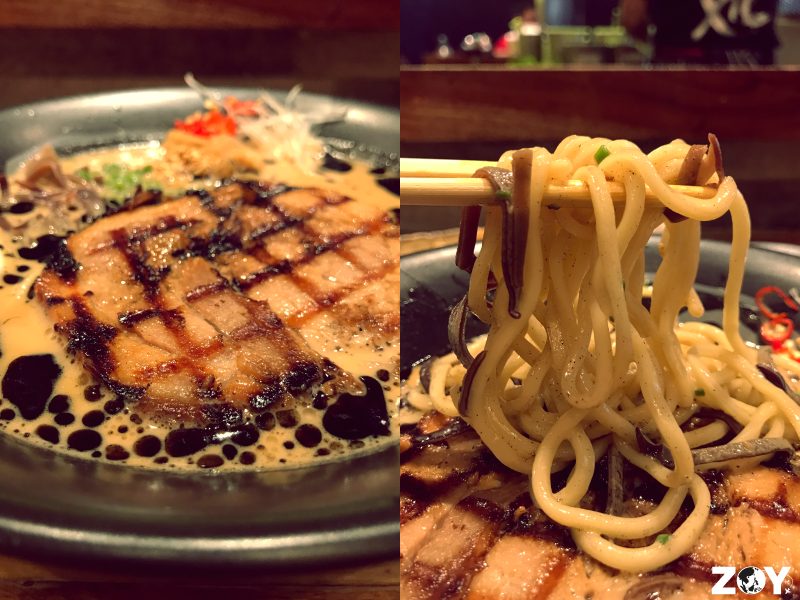Mendokoro Ramenba and Ramen Yushoken: Trying Branch Exclusives of My Favorite Ramen Shops
Buta Kakuni Ramen of Mendokoro Ramenba Salcedo Village
Years ago, the ramen craze hit Manila. I remember my friends, at one moment, were discussing on which shop has the best ramen. Apparently, they have already tried a lot of ramen. There was I in the conversation, listening and couldn’t relate.
Then in 2018, a friend treated me in a jampacked ramen joint in Makati. (Actually, he just subsidized it. LOL.) We queued for an hour, got seated in the counter, slurped the broth, and finished our bowls. It was magical! I was asking myself what I was doing when the craze was making people nuts over their favorite ramen. Anyway, I was glad my friend subsidized my meal. But even if he didn’t, I would be willing to pay the full amount to experience that ramen bliss.
The shop? Mendokoro Ramenba.
Mendokoro is a ramen bar (I’m supposing the ramenba means “ramen bar”) that started in Salcedo Village, Makati and has branched out to Bonifacio Global City (BGC) and Alabang. It’s founded by Elbert Cuenca and Ryan Cruz, who are the brains behind its predecessor, Ramen Yushoken. Both ramen joints are consistently at the top of many Best Ramen in the Metro lists. I haven’t tried a lot of ramen but I’ll be bold enough to claim that theirs are indeed the best!
Mendokoro Ramenba Salcedo Village. There is still a long queue even in a pandemic!
The ramen joints are known for not allowing takeaway. This is to preserve the quality of the ramen (kudos to their commitment to quality!). I think that the time between getting your cooked ramen and eating it at home has an effect on quality. Perhaps they deemed it best to be eaten immediately. But at the height of community quarantines last year, they released Take Home Ramen Kits, which are do-it-yourself (DIY) kits. In this way, customers get the prepare the ramen at home and still consume it immediately. I thought of doing an article about their DIY kits but decided that it’s still better to endure the lines and eat ramen at the shop.
Mendokoro and Yushoken are best known for their Shoyu (soy sauce base), Tantanmen (chili and sesame base), and Miso (fermented soybean base) ramen. But for the purposes of this article, I’ll feature some of the exclusive items (ramen and non-ramen) per branch, starting with Mendokoro Salcedo branch and Yushoken. I haven’t been to other branches lately so I’ll just update this article when I do.
At Ramen Yushoken
But before we proceed with the food, let me highlight what Mendokoro and Yushoken have done to ensure the safety of its customers. Aside from the usual protocols like mandatory wearing of face masks and shields and filling of Health Declaration Forms, they have placed acrylic barriers on their signature u-shaped bar/counter to shield diners from one another (at least, in Mendokoro Salcedo where I visited).
Also, I like that the utensils come to diners wrapped:
While they allow customers to remove their face shields upon entry of the premises, they only allow them to remove their face masks when eating. In fact, if their staff notices that you’re done with your bowl and just conversing with your seatmate, they’ll politely ask you to put your face mask on. Kudos also to their commitment to their diners’ safety!
Now, let’s start with the first item:
Buta Kakuni Ramen (Mendokoro Salcedo)
This was recommended to me by the staff. And when a staff recommends, I listen!
From its name, this ramen comes with pork (buta) belly that’s squared and stewed (kakuni). The humongous block of pork is tender and retains a nice chew (compared to Mendokoro’s signature Chashu [Japanese braised pork belly] which is melt-in-the-mouth soft).
Buta Kakuni Ramen (P590)
The broth is rich, smooth, nutty, and slightly spicy due to chopped chilis. Swimming in it are chewy and thicker-than-usual noodles and ground pork. The bean sprouts add a nice crunch.
The noodles are thicker than usual!
Chahan (Ramen Yushoken)
Chahan is Japanese-style fried rice. But what made Yushoken’s extra special is that it has delightfully chewy chashu bits.
Chahan (P300)
The chahan is nice to be paired with Yushoken’s Karaage (more on this later!).
Garlic Shoyu (Mendokoro Salcedo)
If you are a garlic lover like myself, then his is the ramen for you!
Garlic Shoyu (P495)
Its broth is rich, creamy (maybe even milky!), and garlicky, and its noodles are al dente. You’ll find 3 kinds of garlic here: Garlic chips, fried garlic bits, and raw garlic! If you don’t find this garlicky, then I don’t know what else would!
Garlic, garlic, garlic!
This ramen also comes with a slice of tender chashu, and there are bean sprouts and cabbage to add a nice crunch.
Karaage (Ramen Yushoken)
Karaage is simply Japanese fried chicken, usually made of boneless, skin-on chicken thighs covered with potato starch. Yushoken serves 5 massive pieces of juicy and tender karaage per order.
Karaage (P320)
Juicy and Tender Karaage!
There’s nothing spectacular about Yushoken’s karaage. But I think that karaage is supposed to be that way, simple and comforting. Besides, what can beat a good fried chicken drizzled with lemon and dipped in Japanese mayo?!
Karai Miso Tsukemen (Ramen Yushoken)
Honestly, I’m not a big fan of Tsukemen (dipping ramen) for a simple reason: I’m too lazy to chopstick my noodles and dip it into the broth. That’s extra movement for me! LOL. Plus, when I’m in Mendokoro or Yushoken, I’d rather have their ramen. But since the only noodle exclusive of Yushoken is a tsukemen (if I’m correct), I might as well order it. I travelled all the way south to Alabang so I had to maximize the opportunity!
The Karai Miso Tsukemen comes with a dipping broth that’s rich, creamy, and nutty. It’s also spicy because of the chili oil and slices of chili. I was warned that it’s spicy but for someone who loves all things spicy, it’s very manageable to me. There are also ground pork and soft tofu, making me feel that the dipping broth is like Mapo Tofu.
Karai Miso Tsukemen (P530)
The noodles are thicker than the typical ramen noodles. I think it’s the same one used in Buta Kakuni Ramen.
Super Chashu Ramen (not an exclusive!)
Okay, this ramen isn’t an exclusive of any branch. BUT I have and want to put it here!
I’ve never heard of this variety before, although it’s said to be available long ago off the menu. It has a bigger portion of chashu, which is double marinated and weighs 150 grams! Think of it as Mendokoro’s shoyu ramen on steroids!
Super Chashu Ramen (P560)
I’ll say it right away: It’s phenomenal! Like other Mendokoro ramen, the broth is rich and flavorful and the noodles are perfectly chewy. But what stood out, quite obviously, is the massive piece of chashu, which is tasty and ultra tender. In fact, it disintegrates with a few chopstick presses! I guess it’s called “super” not only because of its size but also of its quality!
The Super Chashu Ramen is so good that I made it my Top 1 dish for the year 2020! (Check out my Top 5 list here.)
What Mendokoro or Yushoken branch exclusive should I try next? Comment them below!














